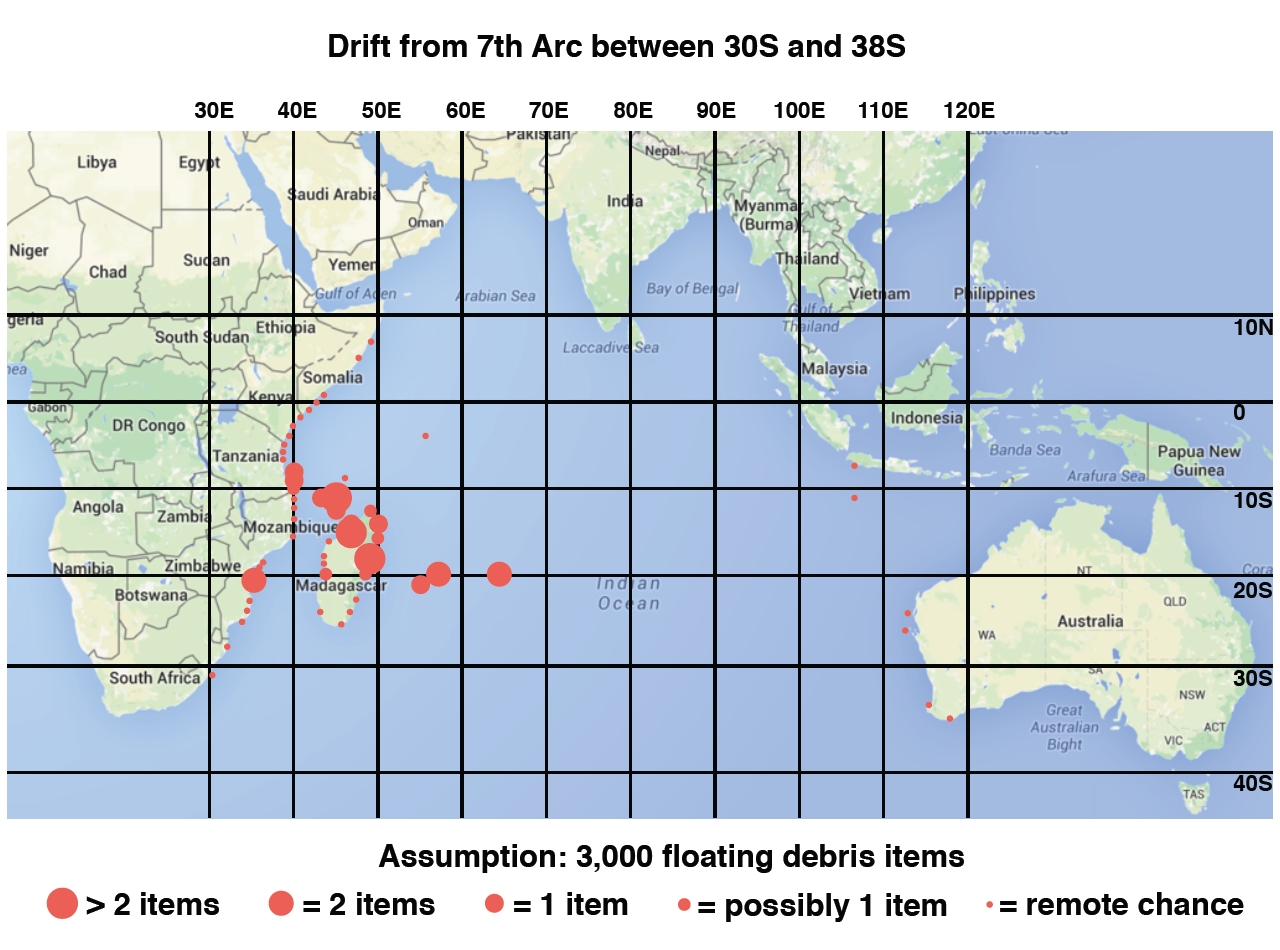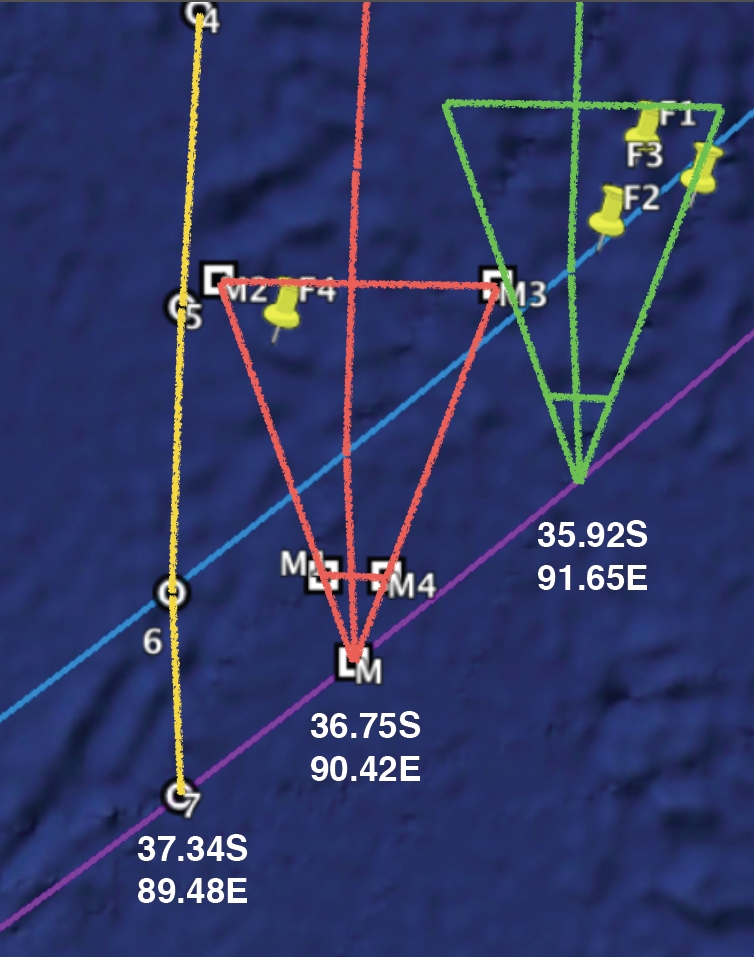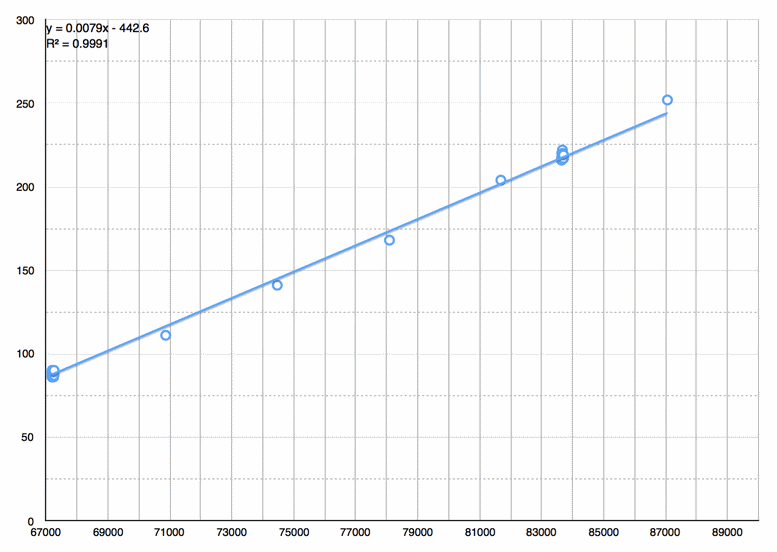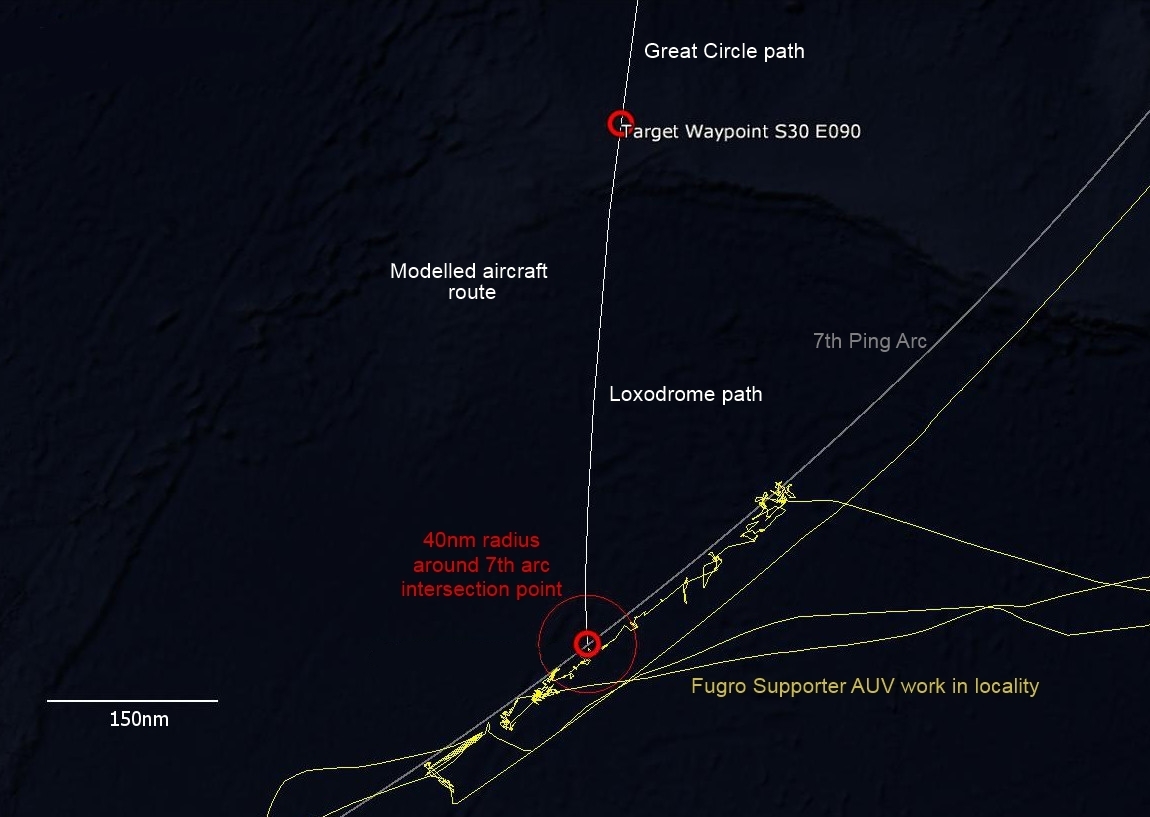Destinations of Floating Debris from MH370 Starting on the 7th Arc between 30S and 38S
Richard Godfrey
2016 March 30th
Updated March 31st
(Report drafted March 16th)
Introduction
In a previous post I investigated the drift patterns across the Indian Ocean of floating debris from MH370 starting at an assumed crash location at latitude 37S and on the 7th arc, using the Adrift model. I have now widened my analysis to include all start points on the 7th arc between 30S and 38S, and summarise the results in the present post.
This analysis covers the time frame from 12 to 24 months after March 2014 (i.e. essentially, through to the present, when parts from MH370 are being found in the western Indian Ocean and beyond [Mossel Bay]), with the time/location mapping comprising 60,270 cells whose centres range in latitude from 21N to 44S, and in longitude from 8E to 149E. This area includes coastlines from Somalia to South Africa, and from Java to Australia.
A clarification of the mapping may be useful, this mapping having been done both in a geographical sense, and also a time sense. First, on the geography. The latitude and longitude bounds given above represent a total number of 1° × 1° cells equal to 66 × 142 = 9,372. However, many of those cells are entirely covered by land, and so floating debris cannot drift into or through them! Second, the drift modelling comprises two-month steps stretching from 12 months to 24 months post-crash, counted inclusively; that is, there are seven time junctures involved (12, 14, 16, 18, 20, 22, 24). These might be considered as being ‘snapshots’ of the situation with regard to the overall drift paths of the floating debris items. A probability cut-off of 0.00025 (one part in 4,000) is applied to each cell at each time step, and only those cells having probabilities of at least that value at that time are represented in the spreadsheet. This results in the 60,270 cells stated above, and that is the number of data rows in the analysis spreadsheet that is described and linked below. Thus it is feasible that some geographical cells may appear in the spreadsheet at every time step, but it is also possible that many cells may appear only spasmodically, or not at all, because debris is very unlikely to have reached them (or remained within them) over the 12—24 months considered.
The time steps are two months long, as aforementioned; at a typical average speed of 0.1 knots such a time step represents a distance travelled of about 144 NM. The drift cells are one-degree wide in both latitude and longitude (i.e. up to about 60 NM across).
Results
The results of this analysis are available in an Excel spreadsheet. Within that spreadsheet I have highlighted in green the potential landfall locations (i.e. those geographical cells that contain a coastline). The latitude and longitude of the centre of each cell is given by the numbers in columns C and D of the spreadsheet.
Also highlighted in the spreadsheet, in red, orange or yellow, are three geographical locations where confirmed finds of MH370 debris have been made. Those locations are given by the first three rows in the table below:

The Mossel Bay item has not yet been included as a ‘find’ in the spreadsheet, pending its confirmation (plus, indeed, another potential find in South Africa announced in the past few days).
The red/orange/yellow scale indicates the probabilities, in descending order, that the landfall at each of those three places was in a certain time slot between 12 and 24 months (those time slots being indicated by the values in column B of the spreadsheet) given an assumed start latitude on the 7th arc (as indicated by the values in column A), the calculated probabilities in all cases being given by the number in column E.
Based on an assumption that there were 3,000 floating debris items, by multiplying the probabilities in the spreadsheet by that number I was able to produce a map as below, indicating where (and how many) items might be anticipated to have made landfall by now. (This assumed number — 3,000 — represents a form of normalisation: it is the required initial number for there to be at least one item being found found on La Réunion. In reality the number of floating debris items might well be substantially higher.)

Comparing the map above (for start locations spread between 30S and 38S on the 7th arc) with my previous map (pertaining to a single start point at 37S on that arc), the most likely locations for items to reach remain the northwest and east coasts of Madagascar, as well as the island of Mayotte at the northern end of the Mozambique Channel (> 2 items). The next most likely destinations are Mozambique, Rodrigues, Mauritius, La Réunion, the Comoros, and Tanzania (at least one item each).
Note that the map above indicates only debris item locations where landfall has occurred. The previous map included items (indeed, the vast majority) still at sea.
Conclusions
The most likely landfalls (i.e. the largest dots in the map above) are from a starting point on the 7th arc at 33S, but there is little difference between starting points ranging from 30S to 38S. All high-probability end points are reached from all starting points on the 7th arc between 30S and 38S.
The most likely starting point on the 7th arc for the three confirmed MH370 debris finds (i.e. the flaperon in Réunion, and the two items found in Mozambique and recently stated to be almost-certainly from MH370) is 30S, but there is little difference between starting points ranging from 30S to 38S. Future debris discoveries and the confirmation of already-found items (e.g. the Mossel Bay fragment; see below) will enable this line of drift analysis to be extended.
Whilst I would not want to draw any conclusions from the drift modelling alone, the above confirms that the discovery of floating fragments from MH370 coming ashore now is consistent with the crash having been close to the 7th arc and between 30S and 38S. There appears to be a preference for latitudes towards the northern half of that range, but ocean drift modelling is not (and cannot be) deterministic, as such.
There are other lines of evidence that support a crash at between 30S and 34S. In preceding posts a variety of possible flight paths, including hybrid routes, have been investigated. In a post in early January an analysis by Henrik Rydberg was included, this concerning comparative likelihoods of ending up at different latitudes on the 7th arc based on the assumed autopilot roll mode. Henrik showed that the ‘Normal’ modes (either Magnetic Track or Magnetic Heading) produced latitudes generally north of the ‘True’ (Track or Heading) modes, mostly between latitudes 30S and 34S. Professional pilot opinion (as pointed out by Mike Exner) has consistently been that for an autopilot-directed flight continuing past a last-entered waypoint, the Normal (i.e. Magnetic) modes are the most likely to be followed.
There are also, though, lines of evidence that count against a crash at 30S-34S. Pre-eminent is the flight-path modelling based on the Inmarsat data, but there is also the fact that the airborne search for floating debris in the weeks following the crash covered much of the 7th arc between 30S and 34S without identifying the extensive debris field that surely existed. Note that the 7th arc between 34.5S and 37S was not covered in the airborne search. Once more fragments of MH370 are found, the balance of probabilities based on drift modelling may well shift back slightly southwards towards that gap.
Mossel Bay debris find
This item has yet to be confirmed to originate from MH370, but obviously it seems very likely to be so.
I have used the Adrift model to calculate the probability of an item of floating debris reaching Mossel Bay in South Africa from the 7th arc (and somewhere between 30S and 38S) after 24 months. The result is 0.027 per cent. To render a probability of one item of floating debris reaching Mossel Bay after this interval, 3,700 floating debris items must have started in the water at the 7th arc.
Notwithstanding the above (i.e. I tried all start locations between 30S and 38S), the only starting points that deliver debris to Mossel Bay are between 30S to 34S, with 30S to 32S being the most likely.
The time frame for the first arrival is 21 to 25 months, where 23 months is the most likely.
Note that, according to the drift modelling described herein, Mossel Bay was not the most likely place in South Africa for debris to be found at this juncture: in the map above there is a larger probability further northwards on the eastern coast of that country. A general picture that emerges is that floating items from MH370 may be moving slightly faster than the Adrift model predicts.
Notes on the lack of debris from Air France flight AF447
Some people have asked the following basic question: “How is it possible that we have several pieces of debris from MH370 found onshore after two years, but no one has claimed to have found any AF447 debris washed up on a coastline after six years?” This is a valid question to ask, and it can be answered as follows.
About a thousand items of floating debris were recovered from the ocean in the case of AF447, but none in the case of MH370. This reduces the odds to start with: some substantial fraction of the floating debris from AF447 was cleaned up, in essence.
Further floating debris quite likely will have escaped the AF447 search, but some will have become water-logged and subsequently sunk.
For the rest of the floating debris, in the six years and (almost) ten months since the AF447 crash, the most likely landfall locations are as follows (in descending order of probability):
Cameroon
Equatorial Guinea
Gabon
These three countries have a combined coastline of 1,583 km and are sparsely populated, apart from Douala and Libreville. They are not major beach tourism centres (unlike La Réunion and various other places in the western Indian Ocean). One might note that such tourism could enhance the likelihood of aircraft debris being recognised in at least two different ways: (a) The tourists tend to be more aware of the possibility of debris from air crashes than the local population, and of course they mostly flew to the resorts themselves; and (b) Beach resorts and/or local authorities employ staff to keep the beaches clean of flotsam (as indeed is the specific case of Johnny Begue in La Réunion).
Returning to the question of AF447 debris, many other destination countries are possible candidates but with much lower probabilities than the above three nations. The following were selected simply to show the wide spread that is feasible after six years have elapsed:
Nigeria
Ghana
Barbados
Spain (northern coast)
British Virgin Islands
Bahamas
Turks & Caicos Islands



